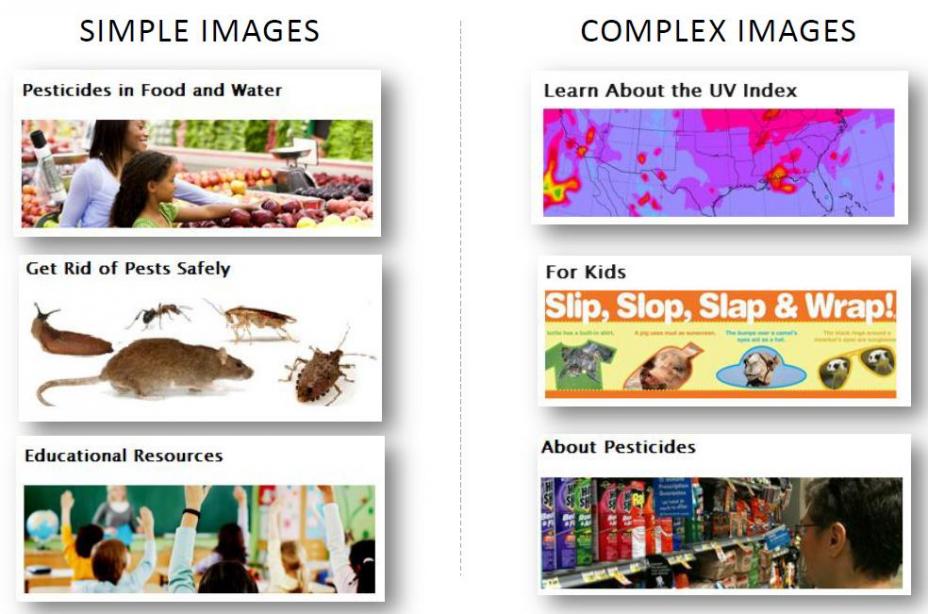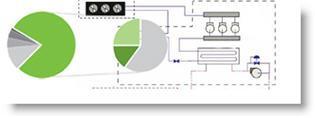Image Guidance
Images for resource directories and microsites are critical to web visitors' experiences on epa.gov. Testing has shown that our visitors consciously and subconsciously use images to help locate content that accomplishes their top tasks.
When the Office of Web Communications (OWC) reviews a new or existing web area, it will review the images in that area in order to determine whether they conform to: EPA web standards, policies and other requirements, including Section 508 requirements and standards of professional quality. The Image Standards sections of this page discuss these requirements further.
In addition, OWC reviews and has final approval of the selection of images used on (a) microsite home page banners, and (b) resource directory hub pages (main body content). Options for selecting and developing these images are described below in the Process sections of this page.
On this page:
- Image Standards: Requirements and Resources
- Image Standards Specific to One EPA Web: What the OWC Image Team Will Look for When Choosing or Reviewing Images
- Options for Creating Images When You Develop a New Web Area
- Process for Selecting and Editing Images:
Image Standards: Requirements and Resources
General Standards and Policies
- Web Standard: Graphics. Includes information on meeting Section 508 requirements.
- Web Standard: Graphic Logos
- One EPA Web Image Standards (set forth below)
Copyright Standards and Policies
- Requirements:
- Use only images you have permission to use:
- Images you or OWC have licensed (for example, through stock photo websites); or
- Images for which you or OWC have bought the copyright; or
- Images for which you have obtained written permission from the copyright owner; or
- Images free of copyright; or
- Images owned by EPA:
- A large number of EPA photos are available on the Office of Multimedia's intranet site Intranet. Click on the Event Gallery, Stock Gallery and Panoramic Gallery links on the left.
- EPA Office of Web Communications Resource Directory Images Gallery.
- Obtain releases/consents from photo models/subjects where applicable.
- Warning: Do not assume that photos on websites managed by other programs or regions or on other agency websites, including any images found through the Web CMS Image Library, are free of copyright.
- If you are interested in using an image that is in a web area of the Web CMS, you can try contacting the Editor in Chief (EIC) of that area to find out if he knows who owns the image. To reach out to the EIC, you can either (a) try contacting the EIC through the "Contact Us" page of the web area where the image is located, or (b) send an email directly to the EIC. The most accurate list of web area EICs is located in the Web Plan, which is located on the Resources for Web Policies and Procedures page.
- If you are using the Web CMS Image Library to select and use an image on a page you are developing, you should follow these steps:
- DO NOT use the "Add files and images" tool in the Edit View of your page to find an image that you can use. Instead,
- Go to the Files tab of the Dashboard (you must first log in to access this page) and search for appropriate images. Once you have selected one you would like to use,
- Note the LAN ID of the file's owner. The owner is found in the User column across from the image.
- Determine who the file owner is; what person is associated with the LAN ID? If you can't tell by looking at the LAN ID, contact Web CMS Support.
- Contact the file owner to determine whether the image is free of any copyright, restriction or license requirement that would prohibit you from reusing the file owner's image. If the file owner can't tell you which category 1-5 above the image falls into, don't use the image, because it may be that the file owner didn't get all required permissions to use it in the first place.
- Use only images you have permission to use:
- Resources:
Options for Creating Images When You Develop a New Web Area
Option 1: OWC develops the images. To help you, OWC can develop these images for you, selecting them (OWC has access to stock images and EPA-created images) and editing them to match your site's needs. If you decide to have OWC develop images for a home/hub page, you may also suggest image ideas or submit particular images for OWC to consider.
Option 2: You develop the images. Aside from a few priority topics where OWC might require that it develop images, you may develop your own images. You are then responsible for meeting the standards discussed on this page and for following the requirements relating to images in the How to Submit Your Web Area for Review section of the Office of Web Communications Process for Web Area Review page. OWC has final approval of image selection.
Process for Selecting and Editing Images: New Microsites and Resource Directories
Steps to Take if OWC Develops Your Images
- you have identified top audiences and tasks,
- you have reviewed potential content and identified appropriate content; content is rewritten for the Web as needed, and
- content organization is finalized.
- If this is a resource directory, you should:
- develop images for (a) spoke (internal) pages and (b) right side of hub page
- NOT develop images for main body of hub page -- use a placeholder image instead.
- If this is a microsite, you should:
- develop images for (a) internal pages and (b) placement below the banner on the home page
- NOT develop banner images – use placeholder images instead.
Step 2. Your management reviews and approves the site (they will see some placeholder images on home/hub page)
Step 3. Your Web Council member reviews and approves the site (s/he will see some placeholder images on home/hub page).
Step 4. Your Web Council member submits review checklist and list of top audiences/tasks to OWC for content review.
Step 5. OWC content review team reviews and approves the site (site still shows some placeholder images). OWC notifies you, your Web Council member, and the OWC images team that site content has been approved.
Step 6. You work with OWC images team to develop images for resource directory hub page or microsite banners, as applicable.
Step 7. OWC images team notifies OWC, OWC content team, and Web Council member that images have been chosen and included in the site.
Step 8. OWC notifies you and your Web Council member that your site can be published.
Step 9. You publish the site.
Step 10. Want to change an image after the site has been published? See the "Process for Selecting and Editing Images - Existing Microsites and Resource Directories" section below.
Steps to Take if You Develop Images on Your Own
Only steps 1, 6 and 7 differ from the steps in the process described above.
Step 1. You, as the EIC, develop website including all images.
- You have identified top audiences and tasks
- You have reviewed potential content and identified appropriate content; content is rewritten for the Web as needed
- Content organization is finalized
Step 2. Your management reviews and approves the site.
Step 3. Your Web Council member reviews and approves the site.
Step 4. Your Web Council member submits review checklist and list of top audiences/tasks to OWC for content review.
Step 5. OWC content review team reviews and approves the site. OWC notifies you, your Web Council member, and OWC images team that site content has been approved.
Step 6. OWC images team reviews resource directory hub page or microsite banners, as applicable. OWC images team works with you on any images that in OWC's judgment need to be replaced or modified.
Step 7. OWC images team approves hub page/banner images and notifies OWC, OWC content team, and Web Council member.
Step 8. OWC notifies you and your Web Council member that the site can be published.
Step 9. You publish the site.
Step 10. Want to change an image after the site has been published? See the "Process for Selecting and Editing Images - Existing Microsites and Resource Directories" section below.
Process for Selecting and Editing Images: Existing Microsites and Resource Directories
- Banners and all other microsite images: you should develop the images. OWC will not review before you publish.
- Images on resource directory hub pages (main body content, i.e. the images associated with content "chunks"):
- You can develop these images. In that case, please post the proposed image on the hub page in the Drupal staging environment. Send an email to Angela Shogren with the URL; make clear in your email which image(s) is new. You can publish once you receive approval from OWC. OR
- You can work with OWC to select and edit the image. OWC images team will notify Danny when image development is complete. He will then let you know that you are free to publish.
- Other images in resource directories (i.e. images on the right side of hub page, or on spoke pages): you should develop these images. OWC will not review.
One EPA Web Image Standards: What the OWC Image Team Will Look for When Choosing or Reviewing Images
- Simplicity. Avoid images that are overly complicated or complex. See the sample simple and complex images below.
- One way of choosing "simple" images is to choose those that have a central focal point. Consider images with one or two subjects on a solid background or with the background slightly out of focus (for example, the image of the mom and daughter shopping). Look at the Educational Resources image. Can you spot the focal point?

- Communication. In the main body of a resource directory hub page, choose images that clearly communicate the text of the cluster heading and help visitors understand what content they will find.

- Imagine the information cluster if there were no heading text. Would your visitors still understand what information they are likely to find in the cluster?

What would this image mean to your visitors?
- High Quality. Use images that have an appropriate resolution to ensure image clarity. An image that has been stretched to accommodate the space designated for it is not acceptable.

- Diversity. Ensure that your images that show people show a wide range of people.
- Sensitivity.
- Be sensitive to your subject matter. If your topic relates to adverse health effects, it's more effective to show people concerned about their health than smiling people.
- Avoid cultural stereotypes in your selection of images.
